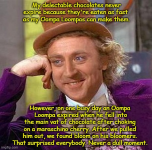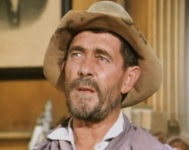View attachment 452327
"Yep. Just be sure you got a backup generator in case the power goes out from storms, hurricanes, or forgettin' to pay your
electric bill. Also, never ever store any chocolate above the bodies, because if your frig and freezer get too warm inside, the
chocolate's gonna melt, and most folks around here don't care much for long pig chocolate fondue. Hint: use Tupperware."
We take the air conditioner for granted, but imagine what life would be like without it.
Once considered a luxury, this invention is now an essential, allowing us to cool homes, businesses, hospitals, data centers, laboratories and other buildings vital to our economy and daily lives. In fact, air temperature is so important to us that 48 percent of all energy consumption in American homes is a result of cooling and heating,
according to the Energy Information Administration
.
Like most important breakthroughs, modern commercial and residential air conditioning technology is a result of a series of advancements by scientists and inventors who challenged themselves to come up with creative solutions to problems of the day. Scroll through our interactive timeline above and read on to learn about some of the key milestones in air conditioning history.
The Evils of High Temperatures
In the 1840s, physician and inventor Dr. John Gorrie of Florida proposed the idea of cooling cities to relieve residents of "the evils of high temperatures." Gorrie believed that cooling was the key to avoiding diseases like malaria and making patients more comfortable, but his rudimentary system for cooling hospital rooms required ice to be shipped to Florida from frozen lakes and streams in the northern United States.
To get around this expensive logistical challenge, Gorrie began experimenting with the concept of artificial cooling. He designed a machine that created ice using a compressor powered by a horse, water, wind-driven sails or steam and was granted a patent for it in 1851. Although Gorrie was unsuccessful at bringing his patented technology to the marketplace -- primarily due to the death of his chief financial backer -- his invention laid the foundation for modern air conditioning and refrigeration.
Wrinkled Pages, Revolutionary Solution
The idea of artificial cooling went stagnant for several years until engineer Willis Carrier took a job that would result in the invention of the first modern electrical air conditioning unit. While working for the Buffalo Forge Company in 1902, Carrier was tasked with solving a humidity problem that was causing magazine pages to wrinkle at Sackett-Wilhelms Lithographing and Publishing Company in Brooklyn.
Through a series of experiments, Carrier designed a system that controlled humidity using cooling coils and secured a patent for his "Apparatus for Treating Air,” which could either humidify (by heating water) or dehumidify (by cooling water) air. As he continued testing and refining his technology, he also devised and patented an automatic control system for regulating the humidity and temperature of air in textile mills.
It wasn't long before Carrier realized that humidity control and air conditioning could benefit many other industries, and he eventually broke off from Buffalo Forge, forming Carrier Engineering Corporation with six other engineers.
Public Buildings Get Cool
At the St. Louis World's Fair in 1904, organizers used mechanical refrigeration to cool the Missouri State Building. The system used 35,000 cubic feet of air per minute to cool the 1,000-seat auditorium, the rotunda and other rooms within the Missouri State Building. It marked the first time the American public was exposed to the concept of comfort cooling. A big breakthrough in comfort cooling technology came in the 1920s, when Americans flocked to movie theaters to watch Hollywood stars on the silver screen.
Early cooling systems for public theaters were essentially heating systems modified with refrigeration equipment that distributed cold air through floor vents, resulting in hot, muggy conditions at upper levels and much colder temperatures at lower levels, where patrons sometimes resorted to wrapping their feet with newspapers to stay warm. In 1922, Carrier Engineering Corporation installed the first well-designed cooling system for theaters at Metropolitan Theater in Los Angeles, which pumped cool air through higher vents for better humidity control and comfort throughout the building.
In May 1922 at Rivoli Theater in New York, Carrier publicly debuted a new type of system that used a centrifugal chiller, which had fewer moving parts and compressor stages than existing units. The breakthrough system increased the reliability and lowered the cost of large-scale air conditioners, greatly expanding their use throughout the country.
Bringing Cooling Home
Despite advancements in cooling technologies, these systems were too large and expensive for homes. Building off refrigeration technology, Frigidaire introduced a new split-system room cooler to the marketplace in 1929 that was small enough for home use and shaped like a radio cabinet. However, the system was heavy, expensive and required a separate, remotely controlled condensing unit. General Electric's Frank Faust improved on this design, developing a self-contained room cooler, and General Electric ended up producing 32 similar prototypes from 1930 to 1931.
Around this same time, Thomas Midgley, Albert Henne and Robert McNary of General Motors synthesized chlorofluorocarbon (CFC) coolants, which became the world's first non-flammable refrigerating fluids, substantially improving the safety of air conditioners. However, the chemicals would be linked to ozone depletion decades later and were eventually phased out by governments all across the globe after the Montreal Protocol in the 1990s. Hydrofluorocarbons (HFCs), which don't destroy the ozone, gain popularity but are eventually linked to climate change.
Recent breakthrough research by the Energy Department's Building Techologies Office and Oak Ridge National Laboratory is resulting in new refrigerants and technologies that are less harmful to the planet.
Home cooling systems got smaller after H.H. Schultz and J.Q. Sherman filed a patent for an air conditioning unit that could be placed on a window ledge. The units hit the market in 1932 but were not widely purchased due to their high cost.
Engineer Henry Galson went on to develop a more compact, inexpensive version of the window air conditioner and set up production lines for several manufacturers.
By 1947, 43,000 of these systems were sold -- and, for the first time, homeowners could enjoy air conditioning without having to make expensive upgrades.
By the late 1960s, most new homes had central air conditioning, and window air conditioners were more affordable than ever, fueling population growth in hot-weather states like Arizona and Florida. Air conditioning is now in nearly 100 million American homes, representing 87 percent of all households,
according to the Energy Information Administration.
Efficiency Standards Drive Improvements
As air conditioning use soared in the 1970s, the energy crisis hit. In response, lawmakers passed laws to reduce energy consumption across the board, setting the stage for the Energy Department’s
Appliance and Equipment Standards Program, which establishes a single federal energy efficiency standard for air conditioner manufacturers rather than a patchwork of state-by-state standards.
Since 1992, the Energy Department has issued
conservation standards for manufacturers of residential central air conditioners and heat pumps. The initial standard is expected to net about $29 billion in energy bill savings from 1993 to 2023. The standard passed in 2006 is anticipated to result in around $70 billion in energy bill savings from 2006 to 2035 and avoid more than 369 million metric tons of carbon dioxide emissions, equivalent to the annual greenhouse gas emissions of about 72 million cars.
The program has already driven huge efficiency improvements in new air conditioning technology that has helped consumers save energy and money. In fact, new air conditioners today use about
50 percent less energy than they did in 1990.
The Future of Air Conditioning
In addition to appliance standards, the Energy Department’s
Emerging Technologies Program within the Building Technologies Office supports applied research and development that makes air conditioning more efficient and sustainable.
Right now, the program
is working on the next big thing in air conditioning: non-vapor compression technology, which doesn't use HFCs that harm the environment, ushering in a new era of cooling. It’s estimated that non-vapor compression technologies could reduce energy consumption by 50 percent.
Learn more about the Energy Department’s efforts to improve the energy efficiency and reduce the environmental impact of air conditioning technologies






